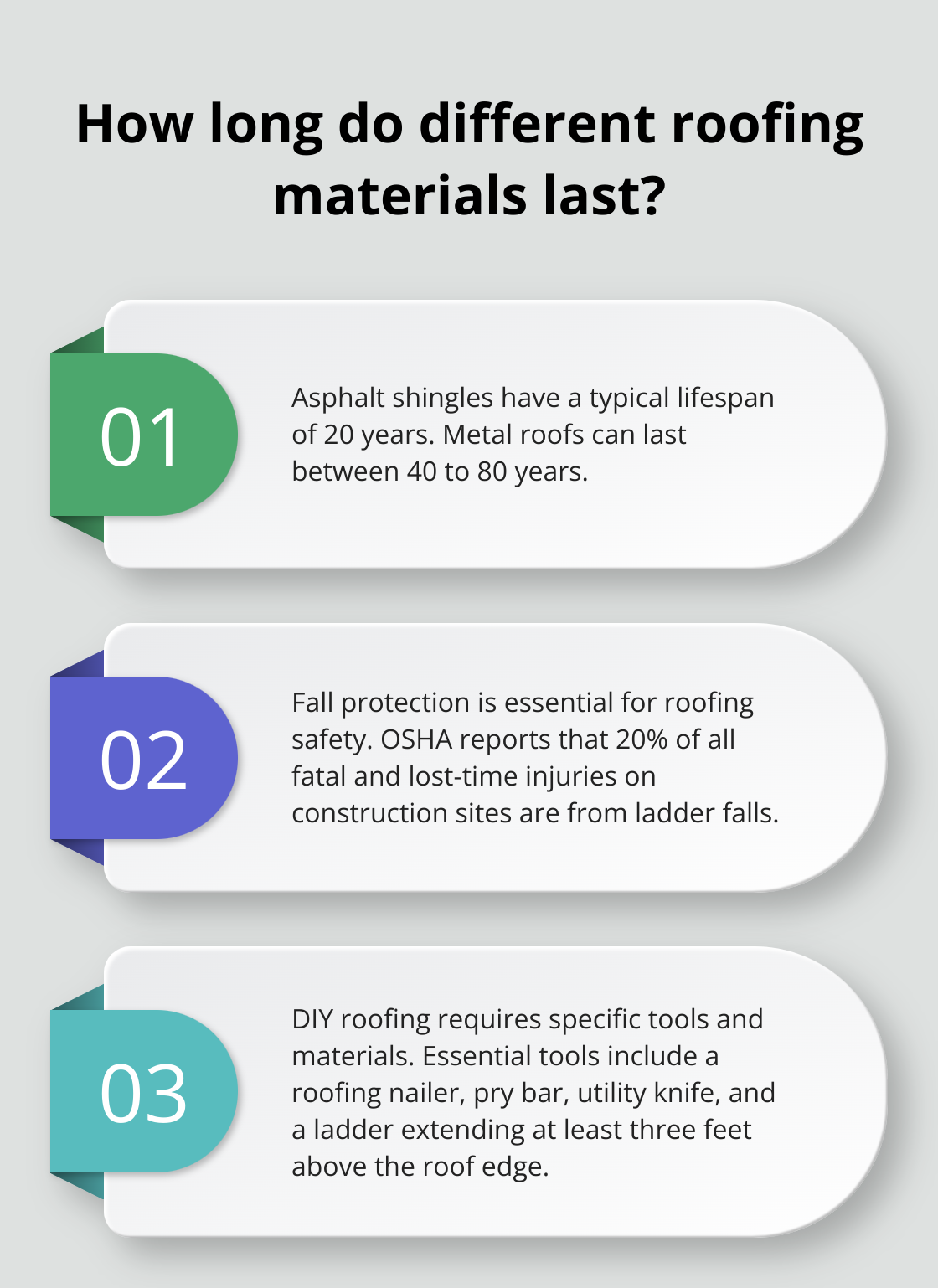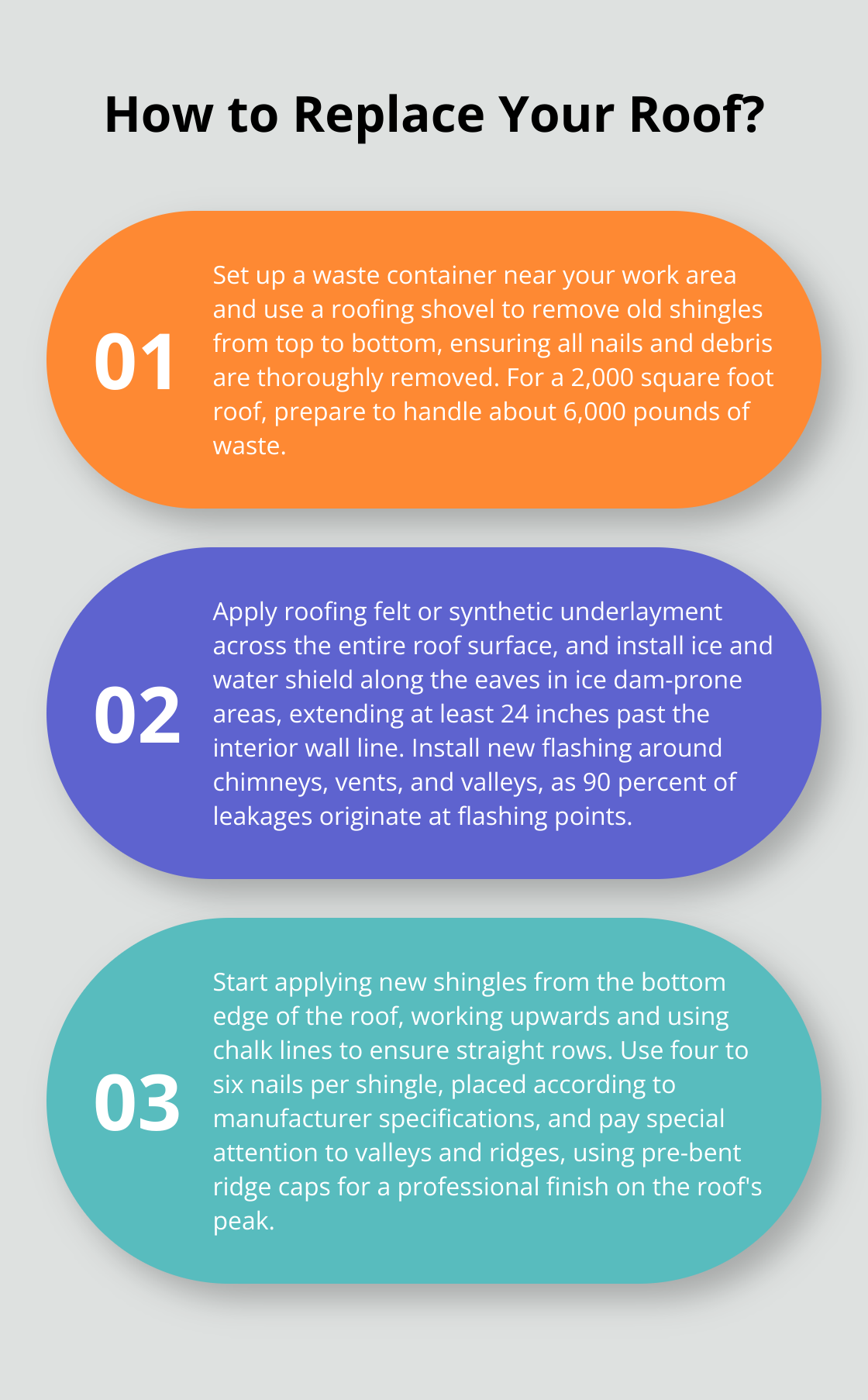Thinking about tackling a roof replacement on your own? At Grandmark Service Company, we understand the appeal of DIY projects, especially when it comes to home improvements.
“Can I replace my own roof?” is a question we often hear from homeowners looking to save money. While it’s possible for skilled DIYers to handle some roofing tasks, it’s important to understand the complexities and risks involved before deciding to take on this challenging project.
Is Your Roof a DIY Project?
Roof Complexity: A Key Factor
The complexity of your roof plays a significant role in determining if it’s suitable for a DIY project. Simple, single-story homes with basic gable roofs are more manageable for DIY enthusiasts. However, roofs with multiple slopes, dormers, or intricate designs increase the difficulty level substantially. The National Roofing Contractors Association points out that complex roof designs require specialized skills and equipment (which most homeowners lack).
Scope of Work: Beyond Shingle Replacement
Assess the extent of repairs or replacement needed. Minor repairs, such as replacing a few shingles, might be within reach for a handy homeowner. However, full roof replacements involve much more than just laying new shingles. You’ll need to:
- Inspect and potentially repair the underlying structure
- Address flashing and ventilation issues
- Ensure proper water drainage
A 2021 survey revealed that 67% of Australians are ‘home improvers’.
Skills and Physical Condition: Be Honest
Evaluate your skill level and physical capabilities honestly. Roofing demands strength, balance, and endurance. Falls are the leading cause of death in construction, with 351 fatal falls to a lower level out of 1,008 construction fatalities in 2020. If you’re uncomfortable working at heights or have physical limitations, it’s best to leave roofing to professionals.
Time and Weather: Critical Considerations
A professional team typically replaces a roof in 1-3 days. For a DIYer, this could stretch into weeks, leaving your home vulnerable to weather damage. Roofing is highly weather-dependent. You’ll need a stretch of dry, mild weather to complete the project safely and effectively.
Professional Consultation: A Wise Choice
If you’re still unsure about tackling your roof replacement after this assessment, consult with a professional. Many reputable roofing companies (like Grandmark Service Company) offer free roof inspections and can provide expert advice on whether your roofing project is suitable for DIY or if professional installation would be more appropriate.

Now that you’ve assessed the feasibility of your DIY roofing project, let’s explore the tools and materials you’ll need if you decide to move forward.
What Tools and Materials Do You Need for DIY Roofing?
Essential Roofing Tools
A successful DIY roofing project requires specific tools. You’ll need a roofing nailer or hammer, pry bar, utility knife, chalk line, tape measure, and circular saw. A roofing shovel or tear-off tool is indispensable for removing old shingles. Don’t overlook a sturdy ladder that extends at least three feet above the roof edge. The Occupational Safety and Health Administration (OSHA) reports that falls from ladders account for 20% of all fatal and lost-time injuries on construction sites.
Safety Equipment: Your Life Depends on It
Safety should top your priority list. A fall protection kit is non-negotiable. OSHA has separate fall protection requirements for roofing work in residential construction versus roofing work in other areas of construction. You must also equip yourself with non-slip boots, safety glasses, work gloves, and a hard hat. A dust mask will protect your lungs from harmful particles.
Roofing Materials: Make the Right Choice
Your choice of roofing materials will impact your roof’s durability and appearance. Asphalt shingles remain popular due to their affordability and ease of installation. Metal roofing, while pricier, offers superior longevity. Metal roofs can last between 40 to 80 years, significantly longer than the 20-year lifespan of typical asphalt shingles.

Don’t underestimate the importance of underlayment, which provides an additional water barrier. Self-adhering ice and water shield is vital for areas prone to ice dams. You’ll also need drip edge, flashing, and ridge caps to ensure a watertight roof system.
Additional Considerations
While DIY roofing can save money, it’s a complex and potentially dangerous task. If you’re unsure about any aspect of the project, consult with professionals. Many reputable companies (like Grandmark Service Company) offer expert advice or can take on the job to ensure your roof is installed safely and correctly.
Now that you understand the tools and materials needed for DIY roofing, let’s move on to the step-by-step guide for replacing your roof. This next section will walk you through the process, from removing old roofing materials to applying the finishing touches.
How to Replace Your Roof Step by Step
Replacing your own roof presents a challenging but potentially rewarding DIY project. This guide will walk you through the process, highlighting key steps and safety considerations.
Remove Old Roofing Materials
Set up a waste container near your work area. Use a roofing shovel to remove the old shingles, working from the top down. Remove all nails and debris thoroughly. This step ensures a smooth installation of new materials.

The National Roofing Contractors Association recommends using galvanized steel or equivalent corrosion-resistant roofing nails for asphalt shingle installation. A 2,000 square foot roof will generate about 6,000 pounds of waste (on average). Check local regulations for guidelines on roofing material disposal.
Inspect and Repair the Roof Deck
After removing old materials, inspect the roof deck thoroughly. Look for signs of water damage, rot, or structural issues. Replace any damaged plywood or boards. The International Association of Certified Home Inspectors states that up to 10% of roof decking typically needs replacement during a re-roofing project.
Use a straightedge to check for unevenness in the decking. Address any dips or bumps before moving forward, as these can lead to problems with the new roofing materials.
Install Underlayment and Flashing
Apply a layer of roofing felt or synthetic underlayment across the entire roof surface. This step provides an additional water barrier. In areas prone to ice dams, install ice and water shield along the eaves, extending at least 24 inches past the interior wall line.
Next, install drip edge along the roof’s perimeter and new flashing around chimneys, vents, and valleys. Proper flashing installation is critical – 90 percent of leakages originate at the flashing points.
Apply New Roofing Materials
Start at the bottom edge of the roof and work your way up, overlapping each course of shingles as you go. Use chalk lines to ensure straight rows. For asphalt shingles, use four to six nails per shingle, placed according to manufacturer specifications.
Pay special attention to valleys and ridges. These areas require specific techniques to ensure water tightness. The Asphalt Roofing Manufacturers Association recommends using pre-bent ridge caps for a professional finish on the roof’s peak.
Prioritize Safety
Roofing is physically demanding work. The Occupational Safety and Health Administration advises taking frequent breaks and staying hydrated, especially in warm weather. Always use proper safety equipment (including harnesses and non-slip footwear) and work with a partner when possible.
While DIY roofing can save money, it’s not for everyone. If you’re unsure about any aspect of the project, consider consulting with a professional roofing contractor. Expert advice and top-quality roofing services (like those offered by Grandmark Service Company) can ensure your roof is installed safely and correctly.
Final Thoughts
DIY roofing attracts many homeowners, but the risks often outweigh the potential savings. Professional roofing contractors offer expertise, efficiency, and peace of mind that DIY projects can’t match. They understand local building codes, handle various materials skillfully, and spot issues that untrained eyes might miss.

The question “Can I replace my own roof?” requires careful consideration of safety and quality. Professional roofers provide proper insurance, warranties, and protection from liability. Grandmark Service Company delivers top-tier roofing solutions for residential and commercial clients in Fresno and Sacramento, with a team skilled in various roofing materials.
Our 4.8 out of 5 rating from over 1,015 reviews and A+ Better Business Bureau rating reflect our commitment to quality. For emergency repairs, specialized commercial services, or comprehensive warranties, Grandmark Service Company stands ready to help you achieve long-term peace of mind with your roofing project.

